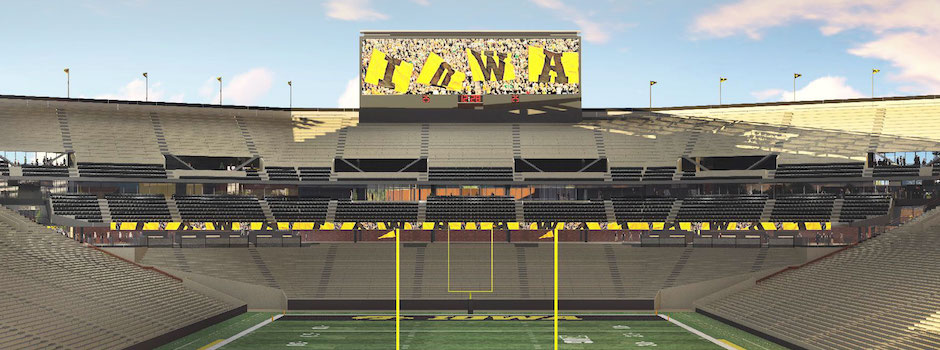Harty: Less is now more with stadium renovations
IOWA CITY, Iowa – When it comes to the viewing experience for big-time college football, less is now more.
Fewer seats means more luxury for those who attend the games in person instead of watching from the comfort of home or from some popular hangout.
Winning and losing still ultimately has the biggest influence on whether fans choose to attend games, but the situation is more complicated than it used to be.
The rise of television, along with everything that enhances the television viewing experience, has made it more challenging to put fans in the seats.
So has the rising cost of tickets and the amount of time that it takes to attend a college football game.
In order to fight the urge to watch from home, schools such as the University of Iowa are taking dramatic steps to improve the game-day experience for fans.
UI officials received word on Thursday that the Board of Regents had approved without discussions all aspects of the $89 million renovation to the north end zone at Kinnick Stadium.
The three-phase project will be a complete reconstruction of the north end zone, featuring second-deck seating, larger concourses, improved concession areas, along with more restrooms and a new video board.
The north end zone also will be enclosed as part of the renovation.
“Kinnick Stadium is recognized as one of the iconic football stadiums in college football,” Iowa athletics director Gary Barta said in a release from the university. “Our primary goal is to enhance the fan experience. We are closing in the north end zone; fans will be that much closer, that much louder and the Kinnick Edge will be that much greater."
In addition to the cost of the project, which is nearly double the original cost estimation, Barta said the renovation also would reduce Kinnick’s seating capacity below 70,000 to around 69,000.
This kind of thing is happening all over the college landscape as schools try to improve the game-day viewing experience.
It’s just too easy right now to watch the game elsewhere than at a stadium squeezed between a bunch of screaming fans at a cost of $60 to $80 per ticket.
Combine being cramped with having to sit through numerous television timeouts and the game-day viewing experience leaves much to be desired, even more so during tough times.
Sellouts used to be common at Kinnick Stadium, but not anymore.
Iowa averaged 63,142 in attendance last season, placing 24th nationally and seventh in the Big Ten. Iowa hasn’t averaged capacity attendance since 2011.
Iowa has had two sellouts this season against Iowa State and North Dakota and no fewer than 67,000 fans for all four home games to this point.
But that is largely the result of finishing 12-2 last season, considering attendance had dropped in two of the previous three seasons.
UI officials believe it is worth sacrificing about 1,500 seats in order to enhance the game-day viewing experience.
And they’re right.
The loss in ticket revenue will be covered partly by having more points of purchase in the concession area.
“University of Iowa football is built on tradition and the cornerstone of that tradition is Kinnick Stadium,” Iowa football coach Kirk Ferentz said in the release. “Every Hawkeye player and coach who has stepped onto that field knows it is a unique place that carries special meaning.”
Fans also know that Kinnick Stadium is a special place and named after a special person and Hawkeye legend.
But for some fans, that still isn’t enough to fight the urge to stay home on game day.
Iowa has to give fans more reasons to fight that urge to stay home than just a successful football team. Because for one thing, Iowa doesn’t always have a successful football team.
Iowa is sacrificing quantity for quality, as are many other schools across the country.
It is the latest example of keeping up with the arm’s race in big-time college football. If you’re not moving forward with regard to facilities, you’re falling behind.
Iowa can’t afford to fall behind because it already has built-in disadvantages like low population.
Work on the project will begin after this season and will take three years to complete. The goal is to have it finished by the start of the 2019 season.
The entire cost of the Kinnick Edge renovation will be completely funded by UI athletics through private support, bonding and athletics revenue.
This will be the first time since 1986 that the north end zone has been upgraded.
“We are grateful to our loyal fans, who continue to recognize our need for these projects and upgrades so that we remain competitive,” Barta said.
The biggest downside to the Kinnick Edge renovation is that ticket prices will continue to rise to the point where some fans simply can’t afford to attend the games. It already has reached that point with some fans.
So with televisions getting fancier and more affordable on a regular basis, why bother with attending a game in person when you already have a great viewing experience at home for a much cheaper price?
The north end zone renovation is part of UI’s answer to that question.



